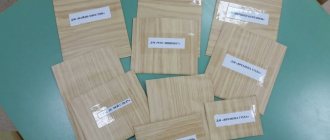card file "Work in a corner of nature" card file (senior, preparatory group)
Card index: Labor in nature. Senior/preparatory group.
Card No. 1.
Watering indoor plants.
Goal: Teach children to care for indoor plants; water from a watering can
water at room temperature; consolidate children's knowledge about different methods of watering indoor plants. Develop accuracy when working with water and plants, confidence in your actions, work skills. Foster a caring attitude towards the natural environment and a desire to take care of it.
Card No. 2.
Loosening the soil of indoor plants.
Goal: Teach children to care for indoor plants; give children knowledge about why it is necessary to loosen the soil of plants; consolidate loosening techniques and rules for using the necessary items for this. Develop labor skills, accuracy. Foster an ecological culture and respect for the environment.
Card number 3.
Spraying indoor plants.
Goal: To teach children to provide all possible assistance to the teacher in caring for indoor flowers: spray the plants with water at room temperature, use the sprayer correctly. Develop labor skills and habits, accuracy when working with water and plants. Foster an ecological culture, a caring attitude towards the natural environment, and a desire to take care of it.
Card number 4.
Caring for large-leaved plants (wet wiping of leaves).
Goal: To teach children to provide all possible assistance to the teacher in caring for indoor flowers: wipe large leaves of plants with a damp cloth, being careful. Give children the knowledge that this method of care makes it easier for plants to breathe, which determines their growth and development. Develop labor skills and habits, accuracy when working with water and plants. Foster an ecological culture, a caring attitude towards the natural environment, and a desire to take care of it.
Card number 5.
Caring for plant leaves (removing dust with brushes and a dry cloth)
Goal: To teach children to provide all possible assistance to the teacher in caring for indoor flowers: remove dust from plants with brushes or dry cloths, being careful. Give children the knowledge that this method of care makes it easier for plants to breathe, which determines their growth and development, and improves their appearance. Develop labor skills and habits, accuracy when working with water and plants. Foster an ecological culture, a caring attitude towards the natural environment, and a desire to take care of it.
Card number 6.
Plant cuttings.
Goal: To clarify children’s knowledge of what a plant can be grown from.
Teach children how to properly plant a plant cutting, prepare the soil, care for them and the sequence of work: pour sand into the bottom of the pot, then soil, water, wait until the water is absorbed into the sand, make a hole in the middle (center) of the pot with a stick and plant the cutting until the first leaf, press the ground. Water as needed. Develop labor skills and habits, accuracy when working with water and plants. Foster an ecological culture, a caring attitude towards the natural environment, and a desire to take care of it.
Card number 7.
Replanting indoor plants.
Goal: To teach children to provide all possible assistance to the teacher in replanting plants; teach plant transplantation techniques and sequences
work: choose the right size pot, prepare sand and soil, plant. To consolidate children's knowledge about indoor plants and their differences from each other. Develop labor skills and habits, accuracy when working with land, water and plants. Foster an ecological culture, a caring attitude towards the natural environment, and a desire to take care of it.
Card No. 8
Planting onions on the windowsill.
Goal: To teach children to set a goal, prepare a workplace, tools and clean up after themselves. To consolidate children's knowledge about the structure of the onion and the conditions necessary for onion growth. Develop labor skills and habits, accuracy when working with land, water and plants. Foster an environmental culture, a desire to achieve results, and participate in a common cause.
Card number 9.
Sowing flower and vegetable seeds.
Goal: To give children knowledge that every plant has seeds. Learn the sequence of actions required when sowing seeds; make a hole in the soil (for sowing seeds, marking each time with a stick
the distance between them and grooves for small seeds; teach to observe cultural and hygienic skills when working. To consolidate children's knowledge about at what time, which seeds are sown in boxes in a group for preparing seedlings, and which seeds are sown in open ground. Develop labor skills and abilities. Foster an ecological culture, a caring attitude towards the natural environment, and a desire to take care of it.
Card number 10.
Planting seedlings and caring for them.
Goal: To form children's ideas about the main stages of plant growth and development (seed, seedling, stem with leaves); about the basic methods of growing plants and caring for them (planting in loose soil, watering, loosening the soil, weeding, feeding). Be careful when planting seedlings, as the plants are very fragile. Develop labor skills and habits, accuracy when working with land, water and plants. Foster an ecological culture, a caring attitude towards the natural environment, and a desire to take care of it.
Program content.To clarify and consolidate children’s knowledge about plant care techniques and the sequence of work. Clarify knowledge about equipment for work and where it is stored. Explain the structure of the duty board. To develop responsibility for the assigned task and the ability to complete it.
Progress of the lesson.
The children are sitting in their places. The teacher, turning to them, says: “Children, today we will talk about how we care for plants, what we do (children list).” Then he asks questions: “How do you know when a plant needs to be watered? (The earth is dry to the touch, light.) What kind of water do we water? (Warm water that has been sitting in watering cans since yesterday.) How should you water correctly? (Invites one of the children to show how to water.) Did Vova water the plant correctly? That's right, he holds the spout of the watering can right above the pot, watering it carefully and accurately. What do we do first, water or wipe the pot, saucer and windowsill? Why do you need to water first? (Then you can spray it on the saucer and window sill, and you will have to wipe it again. The child shows how to wipe the pot.) When all the plants are watered, what else needs to be done? (Pour water into the watering cans and leave them for tomorrow so that the water warms up.) What else is needed to care for plants, besides watering cans? (Rags, bowls, oilcloths.) What should be done with them after the work is finished? (Wipe oilcloths, rinse and dry rags.) Where is everything needed to care for plants stored? (In the table under the aquarium, everything is in its place.)
Since the very form of organizing work turns out to be difficult for children at first (they forget that they are on duty, are distracted, do not finish the job, etc.), the teacher does not initially show them new techniques for caring for plants. They are introduced gradually as the children get used to being on duty. Much attention is paid to organizing duty, especially at first. To develop the habit of being on duty in children, the teacher uses different techniques: reminds some children that they forgot to water the plants or put away their equipment, gives others examples of comrades who are doing their duties well, asks others if they have done everything, and offers to go back and see if this is so, etc. But you cannot focus children only on performing plant care techniques; You should definitely draw their attention to the changes occurring in the plants and encourage those children who have seen more.
In order to give children more time to observe plants while on duty, it is advisable to organize duty in the older group for 2-3 days, but only in the first half of the day, so that the children do not get tired. In the afternoon it is better to use individual orders. Being on duty does not preclude the use of assignments. If there are many plants in a group, not all of them can be served by the person on duty; Some are looked after by children who have received individual assignments—work assignments. These assignments can be sporadic or longer, lasting several days.
From time to time, also in the second half of the day, the teacher gathers those on duty, talks with them about how they perform their duties, what they do and how, what new things they noticed in the plants.
When the children get used to being on duty, the teacher introduces them to new types of plant care: spraying, pruning dry leaves, then loosening the soil; teaches new care techniques. It is better to do this at the end of a lesson on familiarization with indoor plants, and the meaning of each technique should be explained and the children should be provided with the necessary equipment to complete the work. The teacher teaches children how to loosen the soil on plants that have a sufficiently deep root system (so that the children do not damage it).
In the older group, complications are introduced into the types of care already known to children: the teacher draws attention to the fact that in autumn and winter plants hardly grow, many do not bloom, so they need to be watered less often. With the onset of spring, children see that the plants begin to grow, young leaves and buds appear on them. The teacher leads the children to the conclusion that at this time the plants are watered more often. At the end of March - beginning of April, when plant life awakens, they begin to fertilize.
|
MAGAZINE Preschooler.RF
Environmental education. Labor activity in a corner of nature. Lesson notes for children of the first junior group. Topic: “I have a garden - vitamins all year round.” Report for all age groups.First junior group.
In the first ml. gr., children, indoors and on the site, watch how an adult cares for plants and animals. The task of educators is to involve children in joint actions to care for natural objects. Develop a cognitive interest in natural objects, develop a positive attitude and skills of careful handling, the ability to notice the beauty and individuality of each living creature. Since the child’s attention in this age period is not stable, it is advisable to involve children in performing one-time basic tasks: (politely and affectionately ask to bring a scoop, help carry a tray for molds). The order must be really important, because Children at this age already feel when their activities are not needed by anyone.
Second junior group.
In the second ml. gr. household chores, just like in the first ml. gr., comes down mainly to carrying out simple individual assignments. Thus, we cultivate the desire to take part in caring for plants and animals in the corner of nature and on the site. We teach them to notice changes that have occurred in plants they know (lilacs have bloomed, fruits have appeared on the apple tree, etc.) We teach them, with the help of an adult, to feed fish, birds, water houseplants, etc., and also develop skills in handling equipment. The leading type of activity at this age is more than one repetition, sensory examination and practical action. Children's attention is still not stable, so activities should not be too long and monotonous. An adult introduces children to indoor plants, in which the trunk, leaves and their names are clearly distinguishable. These are begonia, various types of ficus, balsam, coleus.
The teacher involves children in caring for plants, shows how to clean the leaves of ficus, chlorophytum, and spathiphyllum from dust, explains that plants hear us and feel our attitude towards them, therefore, when caring for them, you need to talk to them kindly. Children of this age, with the help of an adult, are able to grow green onions from bulbs. For this age group, turtles, canaries, and fish are kept in a corner of nature.
While observing the inhabitants of the aquarium with the kids, the teacher explains what kind of food they like and how many times a day they need to be fed.
Next time he will definitely give two or three children the opportunity to feed the fish themselves. Kids watch the teacher as he plants aquatic plants, places pebbles that support the plants, partially changes the water, cleans the filter, etc.
When getting to know the inhabitants of a living area, an adult can tell children excerpts from fairy tales and read out works by children's writers.
Middle group.
On Wednesday. gr. Household work begins to occupy a significant place in children's lives. The main form of its organization is assignments, which make it possible to systematically involve all students in a variety of work activities. We form the beginnings of a responsible attitude towards the assigned task (the ability and desire to complete the work started), the desire to do it well.
Encourage initiative in helping friends and adults. We deepen knowledge about the needs of living beings. We teach children to systematically care for the inhabitants of a corner of nature. In the corner of nature, zonal geranium, chlorophytum, and asparagus are added to the plants known to children. The teacher explains that different plants have different needs for water. Teaches you to recognize wet or dry soil by the color of the earth and by touch. Shows how to water a particular plant. You can trust children to water on their own without secretly supervising the completion of the task.
From late autumn to the end of March, onions and herbs are grown for birds.
(If there are any). Since February, children can watch the work of a teacher in growing seedlings of peppers, tomatoes, germinating seeds, planting, and picking. Towards the end of winter, you can put a few branches of a tree or shrub in water and draw the attention of preschoolers to how they react to heat and water. In the spring, the teacher introduces children to methods of plant propagation (using the example of chlorophytum). In the second half of the year, the teacher gives children not only individual assignments, but also collective ones. When giving instructions, it is necessary to take into account the characteristics of children: those whose attention is not stable should be given simple tasks (feed the fish). Those who know how to finish what they start are given more complex tasks (watering plants, wiping leaves, loosening the soil). Labor efforts are necessarily assessed by the teacher.
Senior group.
For children in the older group, the teacher teaches them to carry out various tasks related to caring for animals and plants in a corner of nature. Trains you to perform the duties of an attendant in a corner of nature: watering plants, loosening the soil, etc. Draws children's attention to the fact that well-groomed plants look beautiful and are pleasing to the eye. It is important to teach your child to listen to a task, think through a work plan, not interfere with others’ work, help his comrades, not give up on something he has started, and do not be shy about asking for help. New plants appear in the corner of nature (tradescantia, indoor grapes, sansevieria, crinum, Uzalebar violet, rotius). The teacher tells children about the living conditions of plants in nature and how to care for them. For example: in winter, their growth noticeably slows down, watering is carried out less frequently, and plants are inspected more often in order to notice pests in time. Attracts preschoolers to treat trunks and leaves with soapy water. From the end of January to the beginning of February, children are involved in growing vegetables from seeds, seedlings, and from the end of March, flower crops. In the spring, the teacher introduces children to another method of plant propagation: leaf blades (in violets). Tells you how to find out if your indoor plants need replanting. From the beginning of October, the teacher introduces duty in a corner of nature (2-3 people each). On the chart, which is located in a prominent place in the corner of nature, the teacher gives marks for duty in the form of drawings opposite the names. It is especially important to note that there are no bad grades, only “good” and “excellent” .
Preparatory group.
The work of children of this age is more independent. All children can take part in joint work. Children can carry out various tasks related to caring for animals and plant corners of nature (watering plants, loosening the soil, washing feeders, preparing food for fish and birds, etc.). In the fall, the teacher involves children in replanting flowering plants from the ground into a corner of nature. In the corner of nature, children are now on duty for 2-3 days, so they treat their work more responsibly: what was not completed yesterday will have to be completed tomorrow. The teacher teaches them to distribute responsibilities among themselves. The work of growing green onions is now carried out by those on duty. A corner of nature for children of this age now does not cause difficulties. In the preparatory group, new plants appear in a corner of nature: (cyperus, saxifrage, cacti). In February, an introduction to bulbous plants is held. Work continues to familiarize preschoolers with various methods of plant propagation (tendrils, leaf blades, cuttings, rhizomes, etc.) Children's knowledge of the diversity of the plant world is being consolidated.
Educator: Korchevnaya Yu.V. MBDOU No. 57 “Country of Childhood” M.O. Khimki 2015
Lesson notes for junior group 1. Work activity in a corner of nature “I have a vegetable garden - vitamins all year round”
Target:
- Clarify and consolidate children's knowledge about vegetables, how to grow them, talk about the need for light, moisture and heat for plant growth.
- Learn to recognize vegetables by description.
- Talk about the health benefits of onions.
- Foster a desire to plant and care for plants.
Preliminary work:
- Examination of seeds (parsley, dill, onion sets).
- Planting seeds, observing and caring for seedlings.
- Watering and loosening the soil.
- Reading proverbs, sayings and riddles about onions and other vegetables.
Material:
- Cups with loose soil, bulbs for each child, a watering can with water.
- Cippolino doll, illustrations of vegetables, dill seeds, parsley.
Course of the lesson: Children sit in a semicircle.
Children, today guests came to us to see how you can work in our natural corner... (let's say hello)
Guys, but these are not all the guests, yesterday on the way home, I met an onion boy, his name is Chippolino, we talked about plants, about nature, about animals. I told him that in our group there is a corner of nature and invited Cippolino to visit us.
There's a knock on the door. Cippolino appears and says hello. Then there is a dialogue between Cippolino and the children.
Cippolino:
- I heard that in your kindergarten there is a living corner and
I want to find out who lives in it. Tell me, please!
The teacher directs the children's answers to questions.
-Who lives in our living corner? (rabbit Basya, budgies, lovebirds, fish, small Amadina birds, gerbils).
-And recently another rabbit appeared, his name? (Vasya)
-How do we care for our animals? (we feed, watch how adults clean the cages, etc.)
-What else is there in our living corner? (plants).
-What plants? (Ficus, Begonia, Impatiens, Saxifraga)
-How do we care for our plants?
(wipe leaves, water)
Cippolino praises the children and suggests making a nature corner in the group.
Cippolino: Guys, what is in your corner of nature?
Children answer together with the teacher (earth box, earth, seeds, watering can)
Cippolino: children, what vegetables do you know?
Children: (with the help of illustrations they name: cucumber, pepper, tomato, eggplant, cabbage, carrot).
-Tell me, can you solve riddles? (Yes).
The Maiden hid in the ground. A braid sticks out of the ground. I will deftly pull out the Red (Carrot.)
This is not a Fragrant toy at all... (Parsley)
No windows, no doors. Is the room full of people? (Cucumber)
The grandfather sits, wearing a hundred fur coats, and whoever undresses him sheds tears. (Onion)
Cippolino: praises the guys.
Cippolino talks about the benefits of onions and their healing qualities.
— It’s not for nothing that people say onion is a friend to health. Onion and bath rule everything. Onions cure seven ailments.
-Guys, since onions are so useful, let's plant them in the ground and grow them.
The teacher puts Cippolino on a chair and goes to the table where they have prepared (a box for soil, soil, seeds, a watering can). He pours soil into cups and, together with the children, plants onions, dill and parsley. After planting, Cippolino says goodbye to the children and promises to come visit when the harvest grows.
PHOTO
| Next > |



